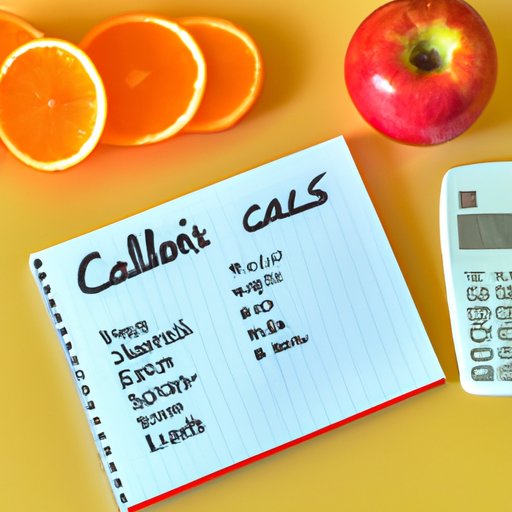I. Introduction
Counting calories is an effective method for maintaining a healthy lifestyle by controlling the food intake. This article is a step-by-step guide for beginners who are new to counting calories and want to achieve their health goals. The target audience is anyone who wants to live a healthy lifestyle and start counting calories. This guide will provide in-depth knowledge of the calorie counting process, the importance of tracking food intake, and how to select the best calorie counting app.
Counting calories also provides various benefits like maintaining weight, reducing the risk of chronic diseases, and reducing the risk of developing health complications. Therefore, it is important to understand how to count calories, and this article will cover everything about it.
II. Step-by-Step Guide for Counting Calories
The process of counting calories involves logging the food you eat and drinks you consume each day and tracking the calorie content of each item. The daily calorie intake for an individual varies due to several factors, including age, gender, body composition, and activity level.
The first step is to calculate the daily calorie requirement to stay healthy and energetic. The formula for this is different for men and women. For men, the formula is: basal metabolic rate (BMR) =88.362 + (13.397 x weight in kg) + (4.799 x height in cm) – (5.677 x age in years). For women: BMR =447.593 + (9.247 x weight in kg) + (3.098 x height in cm) – (4.330 x age in years).
Once the daily calorie requirement is calculated, the next step is to track and log the foods consumed each day. Several apps can be used to log food intake, including MyFitnessPal, Lose it, and Cronometer. Consistency in logging the food is critical.
III. Calorie Counting Apps
Calorie counting apps are vital to track food intake and determine the calorie content of various food items. There are numerous calorie counting apps in the market, and choosing the right one can be a daunting task. MyFitnessPal and Lose It are two popular apps that have gained popularity due to their efficiency, compatibility, and features.
MyFitnessPal allows logging food and exercises, and it has a vast database of food items. Additionally, it has a barcode scanner to scan the food items and add it to the log. Lose it is another app that helps manage food intake by tracking calories and supports meal planning.
IV. Recipe Analysis and Food Labels
Understanding how to read nutrition labels and analyze food recipes is crucial to determine calorie content. The nutrition label contains information on calorie content, fats, cholesterol, sodium, protein, fiber, and carbohydrates. Understanding serving sizes is essential to determine the calorie content.
Recipe analysis is another feature that helps in tracking food intake. Several tools, including MyFitnessPal, allow analyzing the nutritional content of recipes. This helps to monitor calorie content and ensure that the daily calorie intake does not exceed the recommended daily intake.
V. Meal Planning
Meal planning is a critical element in maintaining a healthy lifestyle while achieving weight loss goals through calorie counting. Planning meals helps to ensure that the calorie budget is maintained by keeping a check on the intake and monitoring nutrition. To start meal planning, an individual should first calculate their daily calorie requirement and track food intake.
One way to plan meals is to pre-plan and prep the food in advance. This helps to eat healthy and avoid bingeing on unhealthy snacks. Additionally, choosing healthy alternatives can help to ensure that the daily calorie intake is within the set limit.
VI. Achieving Weight Loss Goals
Creating a calorie deficit is necessary to achieve weight loss goals. The formula to achieve this is by reducing the calorie intake and increasing physical activity. A calorie deficit of 500 to 1000 calories per day helps to achieve a weight loss of one to two pounds per week.
Calculating the optimal calorie intake for weight loss helps to set a goal for weight loss and create a calorie deficit. The formula for calculating the optimal calorie intake is to estimate the BMR, add the calories burned in physical activity, and subtract the calorie deficit.
VII. Conclusion
Counting calories is an effective way to maintain a healthy lifestyle, control food intake, and achieve weight loss goals. This comprehensive guide provides a step-by-step guide to counting calories, choosing the right apps, understanding the nutritional value of recipes and food items, meal planning, and achieving weight loss goals. Start counting calories today and keep track of your health goals!
Successful weight loss and healthy living depend on the small choices we make each day.
